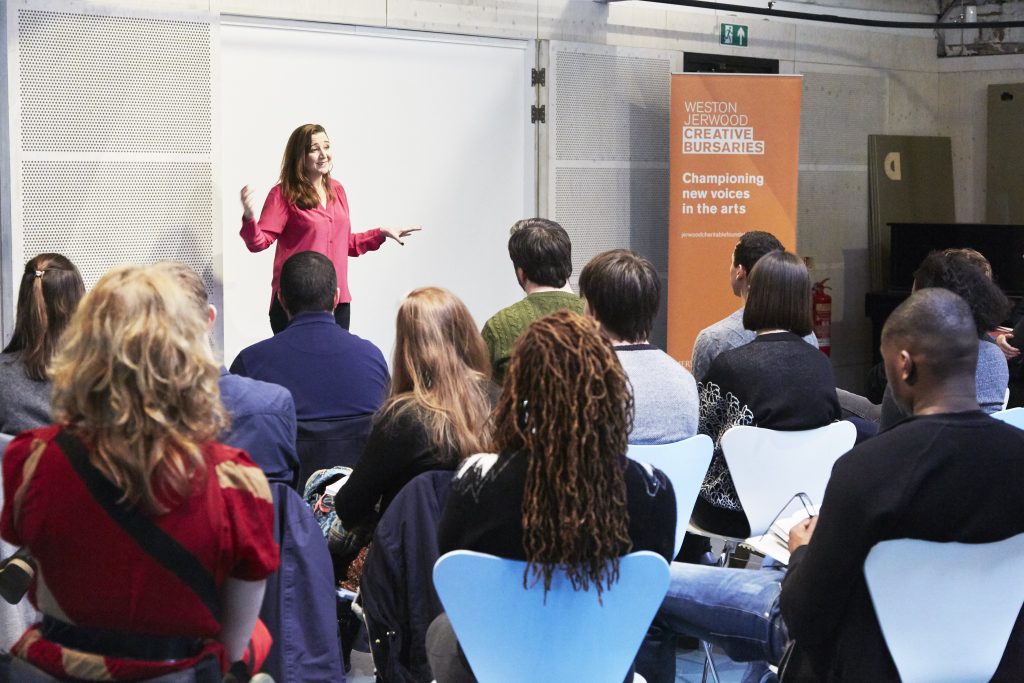Josie Rourke talked about her time as the Artistic Director of the Bush Theatre in Shepherd’s Bush when, in order to raise money to keep the theatre from going under, they targeted the affluent parts of the area to invest back into the community. The Artistic Director of Donmar Warehouse also highlighted the differences between fundraising in England compared to America, where she directed productions in Chicago. Josie’s talk featured some interesting sound bites in relation to fundraising and in particular philanthropy and the types of philanthropists like:
“Individuals are eccentric”
This came from an anecdote where a man who walked in off the street and stayed for 24 hours and then gave a spontaneous and very generous donation related to the 66 Books plays that Josie programmed for the reopening of the Bush Theatre. Another aspect that Josie touched on was the challenge of raising money for the less glamorous aspects of the day to day running of the business. The statement which felt like the underlying message that Josie wanted the audience to take from this talk was that:
“The history of philanthropy is the same as the history of theatre” — @josierourke
Sir Peter Bazalgette opened his talk by making a request for the audience to read the last line from the Chancellor of the Exchequer George Osborne’s 2015 autumn budget statement, which went: One of the best investments we can make as a nation is in our extraordinary arts, museums, heritage, media and sport. – George Osborne This statement proved to be the fuel for Sir Peter Bazalgette’s approach to exploring a range of ways organisations could reach their fundraising objectives. Many of the points that were mentioned can be found on the arts council arts and culture advocacy toolkit.
From a digital perspective, during the talk, I found out that the Arts Council England had funded the video YouTube network Canvas, a channel that showcases video content created from various arts organisations.
”Video is one of our languages and it probably our most powerful language that we use” — Sir Peter Bazalgette
The theme of storytelling started to cross over with the Hollie Smith-Charles practical talk about the fundraising cycle with the reference to the usage of storytelling as well as building and maintaining a journey together with a future funder.
What is the fundraising cycle: 1. Identity 2. Cultivate 3. Ask 4. Steward #culturematters
Create your story 1. Communicate it to your audience 2. Connect to build long-term relationships
Both Josie Rourke and Sir Peter Bazalgette had acknowledged in their talks that local funding is the biggest challenge Arts Council England faces. The importance of making connections outside larger cities becomes even more critical. The important aspect of both talks was that the more people who know your story, then the more possibilities there are for making connections as that story could be passed on via unlikely sources.
During the final talk of the day, Aaron Wright, Programmes Manager, Live Art Development Agency, mentioned how the books on Lois Weaver and Ron Athey (the latter was of many books on display at a recent Pacitti Company reading room event), were made possible via crowdfunding because of the large following both artists had developed over their artistic careers. Aaron also mentioned previous examples of fundraising being the theme for art pieces which provides a more creative approach to this subject area and a guide called ‘Take the Money and Run?’ which can found on the LADA’s resources section of their website.
My thoughts from taking part in the event reminded me of the French sociologist Pierre Bourdieu’s term cultural capital, when two points share interests in a recognizable space to each other then reduces the fear of risk of the unknown and builds on common ground for trust and support.
So in order to build on the relationship with a potential funder, it is key to perform the service that you provide consistently to the requirement of the aspirations that funder would like to see fulfilled. A common phrase used by founders of websites and social media platforms is: They want the thing to give them what they want
Another term that came to my mind was the Pygmalion effect. This is the phenomenon whereby higher expectations lead to an increase in performance. This theme can be seen in many films from My Fair Lady, Pinocchio and Kingsmen.
So it could be seen that fundraising can raise the performance of both funder and fundraiser. From the funder’s point of view, they want to see a project reach its full potential so that it could have a knock-on effect within the ecosystem it operates in like the leisure and hospitality sector. From a fundraiser’s point of view, they do not want to let the funder down since they have backed them and would be willing continue this relationship into future projects. This dynamic produces a reciprocal opportunity for each point to play a part in being a creator… a Geppetto. In creating content and creating spaces for content to be made via various platforms, this can increase connections and hear different points of view which could be a great tool for showing potential investors that they can be part of this story too.
The Weston Jerwood Creative Bursaries programme is a talent development initiative creating work and training opportunities for 40 outstanding new graduates in 40 arts organisations across the UK. The Weston Jerwood Creative Bursaries programme has been made possible through the combined support of Jerwood Arts, Garfield Weston Foundation, Andrew Lloyd Webber Foundation and J Paul Getty Jr Charitable Trust.
Originally posted on Medium
